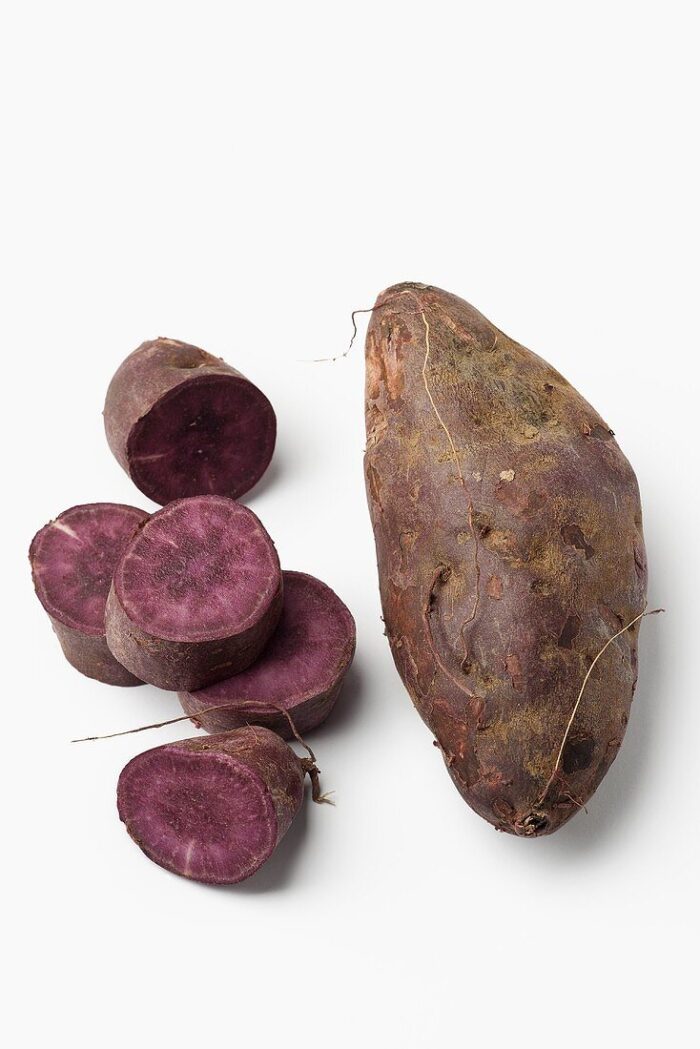Ube and taro are often confused in cooking and desserts. Both have a vibrant purple colour, but they are quite different in taste and texture. Ube is sweet and nutty, while taro has a more earthy flavour.
In the culinary world, ube is popular in Filipino dishes, especially in desserts like ube halaya and ice cream. Taro, on the other hand, is widely used in Asian cuisines such as taro bubble tea and savoury dishes.
Exploring the differences between these two tubers reveals not just culinary uses but also their unique health benefits. Understanding these distinctions can enrich one’s cooking and enjoyment of various dishes.
Classification
Ube and taro belong to different botanical families and have unique origins. Understanding their classification helps highlight their differences and similarities.
Ube Origins and Species
Ube, known scientifically as Dioscorea alata, is part of the Dioscoreaceae family. This plant is native to Southeast Asia and has a rich history of cultivation. Its purple-fleshed tuber stands out as a popular ingredient in desserts and various dishes.
There are other species within the Dioscorea genus, but Dioscorea alata is the most well-known for its culinary uses. Ube thrives in tropical climates, requiring ample moisture and well-drained soil for optimal growth.
Taro Origins and Species
Taro, called Colocasia esculenta, belongs to the Araceae family. It is grown widely in Asia, Africa, and the Pacific Islands. Taro is notable for its heart-shaped leaves and starchy edible corms.
This plant has various cultivars, which differ in size, colour, and taste. Taro prefers wet environments and can often be found in paddy fields. The plant has been cultivated for thousands of years, making it a staple food in many cultures.
Culinary Uses
Ube and taro are popular ingredients in various cuisines, each offering unique flavours and textures. They are commonly used in desserts, snacks, and savoury dishes, making them versatile components in cooking.
Ube in Cuisine
Ube is well known for its vibrant purple colour and sweet flavour. It is commonly used in Filipino desserts. Some popular dishes include:
- Ube Halaya: A sweet, creamy pudding made from mashed ube and coconut milk.
- Ube Ice Cream: This delightful treat is rich and has a distinct purple hue, often enjoyed as a dessert.
- Ube Cake: A light, fluffy cake that incorporates ube for sweetness and colour, often used to celebrate special occasions.
Ube can also be found in pastries and bread, adding both flavour and eye-catching colour. Its unique taste pairs well with coconut, and it can be incorporated into various sweet and savoury recipes.
Taro in Cuisine
Taro is known for its starchy texture and subtle nutty flavour. It is used widely in Asian cuisines, featuring in both sweet and savoury dishes. Key uses include:
- Taro Chips: These crispy snacks are made by frying or baking slices of taro, offering a crunchy alternative to potato chips.
- Taro Bubble Tea: A popular drink that combines taro powder with milk, creating a unique flavour and texture.
- Sweet Taro Soup: This comforting dish typically includes taro, coconut milk, and sugar, served warm or cold.
Taro can also be steamed, boiled, or roasted, making it a versatile ingredient in soups, curries, and rice dishes. Its creamy texture enhances both dishes and snacks.
Nutritional Profiles
The nutritional content of ube and taro differs in several ways. Understanding these differences can help you choose the right ingredients for various diets and health goals.
Ube Nutritional Value
Ube, also known as purple yam, is rich in several nutrients. A 100-gram serving of ube contains about 114 calories. It has approximately:
- Carbohydrates: 27 grams
- Protein: 1.5 grams
- Fat: 0.2 grams
- Dietary fibre: 3 grams
- Vitamin C: Significant levels
Ube is also a good source of antioxidants, particularly anthocyanins, which give it its vibrant colour. These compounds may have health benefits, such as reducing inflammation. Ube is typically low in sodium and cholesterol, making it a healthy choice for many diets.
Taro Nutritional Value
Taro is a starchy root vegetable that provides different nutrients. A 100-gram serving of taro has around 142 calories and contains:
- Carbohydrates: 34 grams
- Protein: 2 grams
- Fat: 0.2 grams
- Dietary fibre: 5 grams
- Vitamin E: Present in small amounts
Taro is also high in potassium, which is important for heart health. Its high fibre content can aid digestion. Taro is gluten-free and suitable for various dietary needs. It is important to cook taro properly, as raw taro contains harmful compounds that can irritate.
Conclusion
Ube and taro are both popular root vegetables in Asian cuisine. They have distinct flavours, textures, and appearances.
Key Differences:
| Feature | Ube | Taro |
|---|---|---|
| Colour | Purple | Light purple to white |
| Taste | Sweet and nutty | Earthy and mildly sweet |
| Common Uses | Desserts, ice cream, cakes | Soups, snacks, desserts |
Both ingredients provide unique qualities to dishes.
Ube is often used in Filipino desserts, while taro finds a place in many Asian recipes. They can be swapped in some instances, but the flavour profile and texture will change.
Nutritionally, both offer health benefits. They are high in fibre and provide various vitamins and minerals.
In choosing between ube and taro, it depends on personal preference and the dish being prepared. Each has its place in the culinary world, contributing to flavour and cultural heritage.


